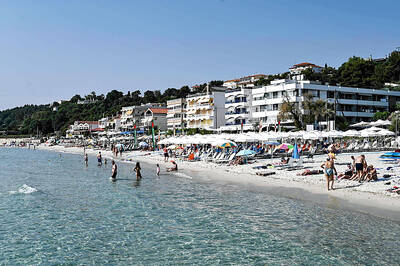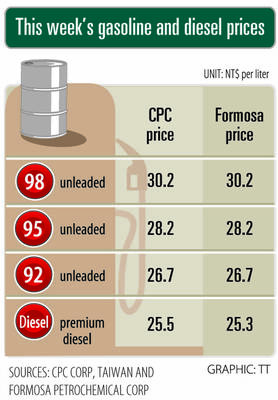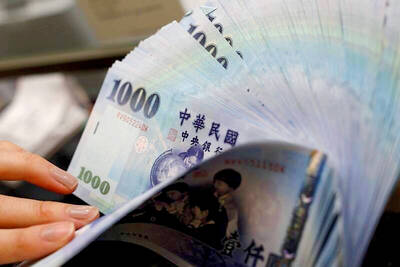Sales of computer monitors in Taiwan expanded at a faster-than-expected 25 percent pace during the third quarter, largely because of strong back-to-school demand and replacement demand from government agencies, market researcher International Data Corp (IDC) said yesterday.
But for the full year, sales of computer monitors will only rise by 4.5 percent from last year, IDC projected without giving specific figures.
State purchases
"Huge back-to-school demand [and] purchases by state-run Central Trust of China (
Central Trust -- whose business operations include banking, insurance, trade and warehousing -- is in charge of purchasing computers and other goods for government agencies and schools.
Strong demand for liquid-crystal-display (LCD) monitors was the main reason for the increase, Wu said.
"Consumers and retailers snapped up LCD monitors in the late third quarter, [rather than in the fourth quarter as in previous years], in anticipation of further price hikes," Wu said.
Consumers purchased LCD monitors and retailers began building up inventory after LCD monitor prices stabilized in the third quarter, after a quarter-long rise in prices, Wu said.
As a result, sales of computer monitors jumped by around 25 percent to 610,020 units from the second quarter, which was 20 percent faster than IDC's previous forecast, the researcher said.
Compared with the previous year, however, the expansion was merely 3.8 percent, as the rising adoption of laptop computers limited growth in desktop computers, she added.
Sales of branded LCD monitors increased to 489,539 units in the last quarter, making up 95 percent of total sales, compared with 92 percent in the second quarter, IDC said. The figure did not include LCD monitors sold bundled with computers, it added.
Meanwhile, sales of the boxy cathode-ray-tube monitors amounted to only 25,000 units, according to IDC.
Slower Q4
Looking ahead, as consumers and retailers purchased LCD monitors in the previous quarter, combined sales of computer monitors would decrease slightly in the current quarter compared with the third quarter, Wu said.
Seventeen-inch monitors remained the mainstay LCD monitor, accounting for 58 percent of all LCD monitors sold in the third quarter, IDC said.
But, sales of 19-inch monitors grew quickly due to falling prices, and made up more than a third of total sales, the researcher said, adding that price hikes in the past quarter were mainly for 15-inch and 17-inch models.
The top four brands in the domestic LCD monitor market are Chi Mei Corp (

Merida Industry Co (美利達) has seen signs of recovery in the US and European markets this year, as customers are gradually depleting their inventories, the bicycle maker told shareholders yesterday. Given robust growth in new orders at its Taiwanese factory, coupled with its subsidiaries’ improving performance, Merida said it remains confident about the bicycle market’s prospects and expects steady growth in its core business this year. CAUTION ON CHINA However, the company must handle the Chinese market with great caution, as sales of road bikes there have declined significantly, affecting its revenue and profitability, Merida said in a statement, adding that it would

Greek tourism student Katerina quit within a month of starting work at a five-star hotel in Halkidiki, one of the country’s top destinations, because she said conditions were so dire. Beyond the bad pay, the 22-year-old said that her working and living conditions were “miserable and unacceptable.” Millions holiday in Greece every year, but its vital tourism industry is finding it harder and harder to recruit Greeks to look after them. “I was asked to work in any department of the hotel where there was a need, from service to cleaning,” said Katerina, a tourism and marketing student, who would

i Gasoline and diesel prices at fuel stations are this week to rise NT$0.1 per liter, as tensions in the Middle East pushed crude oil prices higher last week, CPC Corp, Taiwan (台灣中油) and Formosa Petrochemical Corp (台塑石化) said yesterday. International crude oil prices last week rose for the third consecutive week due to an escalating conflict between Israel and Iran, as the market is concerned that the situation in the Middle East might affect crude oil supply, CPC and Formosa said in separate statements. Front-month Brent crude oil futures — the international oil benchmark — rose 3.75 percent to settle at US$77.01

RISING: Strong exports, and life insurance companies’ efforts to manage currency risks indicates the NT dollar would eventually pass the 29 level, an expert said The New Taiwan dollar yesterday rallied to its strongest in three years amid inflows to the nation’s stock market and broad-based weakness in the US dollar. Exporter sales of the US currency and a repatriation of funds from local asset managers also played a role, said two traders, who asked not to be identified as they were not authorized to speak publicly. State-owned banks were seen buying the greenback yesterday, but only at a moderate scale, the traders said. The local currency gained 0.77 percent, outperforming almost all of its Asian peers, to close at NT$29.165 per US dollar in Taipei trading yesterday. The